There is a sea on the Planet Earth which has no shores. It is over two million square miles in size, and it is completely distinct from its surrounding waters both oceanographically and ecologically. It supports roughly a million tons of plant life, which provides habitat for over 100 species of fish and 140 species of invertebrates, and many of them occur nowhere else. All this teeming abundance is in waters that are so nutrient poor that visibility can be a couple hundred feet on a good day. If not for this astonishing ecosystem, in this astonishing sea without shores, this place would be an aquatic desert.
It’s called the Sargasso Sea. It is contained by a clockwise gyre of four different ocean currents that circle between North America, Europe and North Africa, and it is about 1,000 miles across at its widest point. Its sea level is three feet higher than the surrounding waters, and the waters are warmer and saltier. The foundation of the ecosystem is a remarkable seaweed called sargassum (Sargassum natans and Sargassum fluitans), a highly unusual marine algae that is completely pelagic (free drifting). It reproduces asexually through simple fragmentation, and it can do so easily, and anywhere it goes. Because it is pelagic, it does not have to compete for precious real estate on the ocean bottom, and it also is not limited to shallow coastal waters like the benthic (attached) seaweeds, which not only have to find some substrate to attach to, but then have to be able to grow up into some light so they can photosynthesize. Sargassum has none of those constraints, and it grows in great mats and windrows in a sprawling, mid-ocean world where the coastlines are hundreds of miles away and the bottom is sixteen thousand feet down. It consumes carbon and produces oxygen in huge quantities. It has been called the golden floating rainforest of the ocean.
Sail east from anywhere in the US or west from anywhere in Europe and you’ll probably have to cross it. Sailors have known about it for centuries, and it has broken some strong hearts when the seaweed was sighted from shipboard by early explorers, and they thought they were approaching land.
For myself, I started reading up on it because, though we’ve always gotten a little sargassum on our beaches around here, recently it’s been hitting us in huge quantities. It’s ugly. It’s slimy. It puts out hydrogen sulfide gas as it decomposes and it stinks. The tourists are not pleased. “WTF?” my friends are all asking me—but in that quaint way we older folks have of spelling things out completely.
* * * *
Well, I knew this would be a tough one and I was right. We’ve all read several articles in the popular press about this and none of them answer the question why, so I knew it wouldn’t be easy to find. A week into it I muttered to myself that it might have been easier if I’d been looking up the meaning of life. Then, on a whim, I did so. It’s 42. If you’ve read any Douglas Adams you already knew that. But anyway, bear with me, because I did arrive at what I consider to be an answer, and getting there was a pretty good trip, not just through the life cycle of one of the most interesting seaweeds in the world, but also the amazing Sargasso Sea, the world’s ocean currents, climate change, and agricultural and urban runoff as measured in continent-fulls.
It used to be thought that the Sargasso Sea was a one-way destination for sargassum seaweed. The model went like this: The sargassum grows in the north-west Gulf of Mexico (they’ve always gotten some on the Texas beaches), and that was thought to be sort of its nursery. Then the Gulf Stream current catches it and whips it around the southern tip of Florida and up the east coast of North America, and it settles out into the gyre that is the Sargasso Sea, and there the story ends.
The problem with that model is that it’s a one-way model—the sargassum goes in, and nothing comes out—and ecologists just hate one-way models. To any ecologist with a proper reverence for the Interconnectedness of Everything (capital ‘I’, capital ‘E’), if you’re looking at a one-way system, you’ve only found half the system. It wasn’t until last year that three Texas A&M scientists found what appears to me to be the other half. They developed a way to identify sargassum in satellite photos. If there is enough of it, it reflects wavelengths of light that jump right out at you if you use the right filter. Even if there is not enough to be directly visible, its presence breaks surface tension and dampens wave motion, creating what the scientists call a “slick” on the water. They started going through images, all the way back to the year 2000, which was the earliest year that the photos had enough resolution for this. What they found was that every year, a weather occurrence called the Azores High Pressure System creates strong south-bound winds, and they don’t exactly disrupt this huge North Atlantic Gyre—but they jail-break a bunch of sargassum out of it.
This expanded hugely the travels that we understood Sargassum to make. When it breaks out of the gyre, it drops down through three different passages between the island nations that border the Caribbean on the north—between Cuba and Haiti, between Dominican Republic and Puerto Rico, and between Saint Thomas and Anguilla the sargassum is blown through the passages, and it ends up in the Caribbean, where the North Equatorial Current grabs it and sweeps it west down the same gun barrel that brings us our hurricanes—right at the Yucatan. Then the Gulf Stream grabs it and carries it around the north-east tip of the Yucatan and into the Gulf of Mexico, where some of it continues around the south tip of Florida and up the East Coast again to complete the circuit, but a lot of it eddies backwards into the north-west Gulf of Mexico, where it reproduces wildly and buries the beaches in Texas.
They’re calling it the Sargassum Loop System, and it’s recent news, cutting edge science, and a pretty big discovery, but here’s why it doesn’t answer the question my neighbors are asking me: There seems to be nothing new about it. As far as the scientists can tell, sargassum has been travelling this circuit all along, and it had only resulted in occasional, and not very heavy, strandings of sargassum on our beaches.
But another study got my attention, and when you put the two together you have something.
In 2011, there was a huge episode of this, and in 2012 a scientist named Johnson and a couple of colleagues did a very clever thing. You see, scientists have software models of ocean currents. There is more than one, and people and institutions have worked hard on them, and they’re very detailed and sophisticated, and they do a pretty good job. And Johnson et al had historical data about where the heavy loads of sargassum were, and on what dates. So what they did, effectively, is they dropped some virtual sargassum in their software sea at a few of those places and dates, and then ran the tape backwards.
They were amazed at where it ended up. It wasn’t anywhere near the Caribbean, and it wasn’t anywhere near the Sargasso Sea. It wasn’t even anywhere near the Sargassum Loop System (which actually hadn’t been discovered yet). It was in a huge, elongated eddy that lies just above the equator and reaches all the way from South America to Africa. It’s called the North Equatorial Recirculation Region. While the huge Equatorial Current is taking everything west, this eddy forms above it, bounded on its north by a weak, usually seasonal current called the North Equatorial Counter Current. This explained why there had been landfalls not just here in the Caribbean, which has always gotten some sargassum, but also in places like Brazil, and even on the coast of Africa in places like Sierra Leone, where it had never been seen before and people didn’t know what in the heck they were looking at. And the thing about this eddy, this North Equatorial Recirculation Region, is that it’s swimming in nutrients. It’s west end is right at the mouth of the Amazon River. It also gets iron-rich dust blown over from Africa, and coastal upwelling off that coastline as well. According to their software models, the sargassum stayed there for a “considerable time,” and it just loved that place. It grew exponentially, moving in eddy-like motions and sucking up all that warmth and all those nutrients and creating masses and masses of itself—and then the counter-current broke down. The eddy vanished, the floodgates opened, and all that sargassum started across the Caribbean toward us.
It makes sense when you think about it, because the two biggest rivers in the Americas are the Mississippi and the Amazon. Which brings us to the subject of continental run-off.
I’ve written before about eutrophication, when I did a piece on jellyfish. It’s a word you’ll be hearing more of, unfortunately, as we pummel this planet harder and harder, and sure enough, it figures in this story too. Looked at simply, eutrophication is when excess nutrients wash into a body of water and mess everything up. The first thing that happens is an algae bloom, and that could be anything from phytoplankton to sargassum, and then as that stuff dies, the decomposition process robs the water of all its oxygen, and you end up with what marine biologists call a dead zone. This happens in big ways and small ones—I know divers who can swim down our barrier reef and tell you resort by resort whose septic systems aren’t working. But rivers like the Mississippi and the Amazon empty entire continents of their nutrients, and that now includes fertilizers, pesticides, industrial waste and discharge from sewage treatment plants. You can see the dead zones on Google Earth now. Look for the little dead fish icons. They’re courtesy of William and Mary College and the World Resources Institute (and thank you, Google, for being willing to display them!) The second biggest dead zone in the world is in a plume running west from the mouth of the Mississippi, which is why the sargassum grows so riotously in the north-west Gulf of Mexico, and man, if you think we’ve got problems, you should see the sargassum in Texas. They get it on a classic Texan scale. The piles on the beaches (called wracks) can be ten feet high there, especially around Galveston. When it comes in, they call it the golden tide.
And sargassum isn’t the only seaweed going nuts from eutrophication. On the Brittany coast in France, they got a green tide of sea lettuce (Ulva armoricana) in 2009 that off-gassed so much hydrogen sulfide that it killed a horse and rendered its rider unconscious. In 2011 it returned and killed thirty-six wild boars. The sensational press coverage left everyone with the impression that the seaweed was toxic (it’s not, but hydrogen sulfide is nothing to trifle with). The cause was clear: factory agriculture. Nutrients come in (in animal feed) but they don’t go out (no one returns the manure to sender), so there’s a gargantuan net increase in the nutrients in the Brittany area, and they end up in the ocean. Measures to curtail factory farming caused layoffs, closures and protests. The tourist industry there is 5 million dollars per year. The agriculture industry is 11.6. They’re still fighting.
In China, on the shores of the notoriously eutrophic Yellow Sea, the largest green tide ever recorded hit the beaches of Qingdao three weeks before the Olympics and its sailing regatta. The Chinese rose to it in impressive fashion: In just three weeks they removed a million tons of Ulva prolifera from the beaches in an operation that involved 10,000 people and cost thirty million dollars. Then they put up a boom to keep the stuff out that was thirty kilometers long.
* * * *
So, the picture that’s shaping up in the mind of this amateur naturalist looks something like this: The sargassum spends most of a year, or even more than a year, hanging out somewhere it has never been before, which is in the North Equatorial Recirculation Region, and it circles and blooms and circles and blooms. Then at some point, the countercurrent bounding it on the north dissipates, the eddying stops, and the sargassum floods out, rejoins the Sargassum Loop System and buries our beaches. But there’s a huge question still unanswered, which, of course, is this: How in the hell did sargassum start getting into the North Equatorial Recirculation Region? Nobody knows. Johnson and his team say that the causes “have not yet been elucidated,” but they suspect a link with global warming.
A voice in my head is going, I should have known. Climate change, and eutrophication. Both.
And they could both in theory be fixed, because the good news and the bad news here is that they’re both anthropogenic. Anthropogenic is a scientific term meaning caused by humans. But I prefer how the great Jimmy Buffet would put it:
It’s our own damn fault.
Now you know.
Sources:
-http://eol.org/pages/893154/overview
-http://precedings.nature.com/documents/1894/version/1/files/npre20081894-1.pdf
-http://research.tamu.edu/2015/04/21/app-uses-nasa-satellites-to-track-sargassum-along-texas-coastline/
-http://seas-forecast.com/
-http://mission-blue.org/2014/10/sargassum-inundates-the-beaches-of-the-caribbean/
-http://seas-forecast.com/Pages/stories/Papers/JeffFrazierthesisformatedforpublishingNEW.pdf
-http://www.readcube.com/articles/10.1038%2Fnature12860
-http://www.alertdiver.com/Sargassum-barometer-of-global-change
-http://www.usm.edu/gcrl/sargassum/docs/Sargassum.Invasion.of.the.Eastern.Caribbean.and.West.Africa.2011.pdf
-http://www.tandfonline.com/doi/abs/10.1080/2150704X.2013.796433#preview
-http://www.laht.com/article.asp?CategoryId=14091&ArticleId=2393072

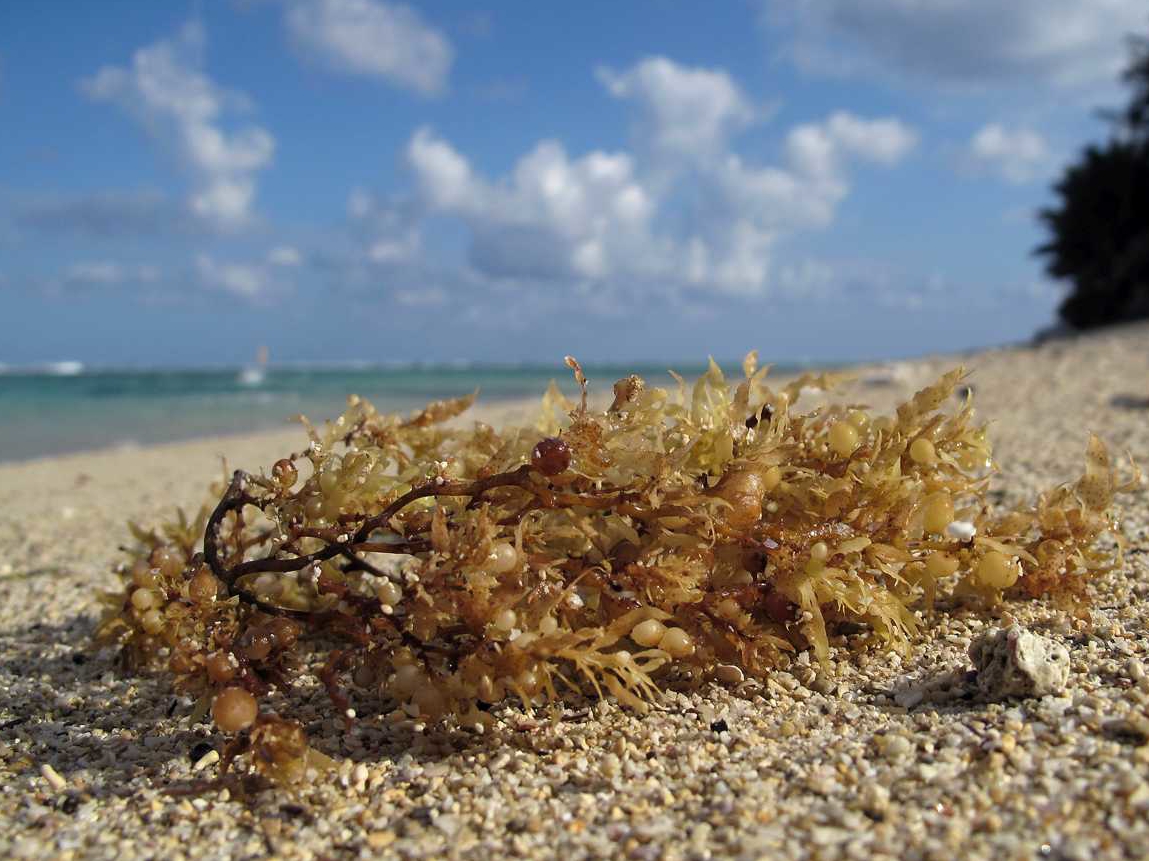
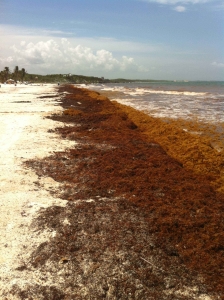
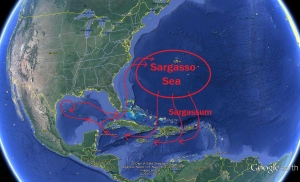
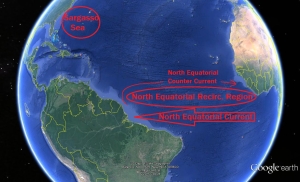
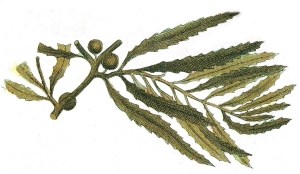
In Bermuda the sargasso seaweed isn’t usually appreciated by the tourists but it does have it’s uses. It acts as a nursery to alot of our marine life and when it washes up it can be used as fertilizer. I wish it was embraced more here.
Glad you enjoyed it, Joi! Yes, sargassum definitely has its roles and its value. I talk about it some in the following article, The Secret Lives of Beaches.
Say hi to Bermuda for us! Must get there someday!
That was a good reading!. From my superamateur knowledge, I 100% agree with you. Eutrophication must be playing a major role.
Although studying a completely different material (not nutrients, but plastic garbage), NASA has recently published a visualization of the ocean garbage patches using data from buoys that NOAA has been releasing in the oceans for the last 35-years. It gives you a good idea on how the dynamics of the sea currents are creating certain patches of stuff. If you check it, there’s a stream that goes directly to the sargassum sea. If it is carrying plastics, it’s carrying everything, including nutrients. Fluid dynamics!
https://www.youtube.com/watch?v=oUKUP2s5_VY
Saludos,
Ivan
Wow, that’s an interesting video! I might have to write an article about those garbage patches someday. Pretty interesting.
Hi Randy,
My friend Martha Gilkes shared this with me and I have subscribed being and amateur oceanographer and environmentalist. We are inundated with the stuff on the east side of Antigua and I have been thinking for a few years that it is nature’s gift that we just have not figured out how to use. We have been burying it on our beach as beach reinforcement and composting it as well. Do you think that, in addition to the other uses that have been suggested, it has any value as food?
Thanks for a great piece. A follow up on how to deal with it and put it to good use would be informative.
Best,
Fred
Fred, you sound a lot like me! I’m on the Yucatan and it’s been wonderful hearing from folks all around the Caribbean. Give my regards to Antigua! I’ll look into eating sargassum. Brown algae of many kinds, especially giant kelp, is in all sorts of food products, so it’s likely but I don’t know. Cheers!
[…] Our snorkeling Captain Raul Carusso also sent me this link to explain why this seaweed invasion is happening. Explaining the Sargassum Seaweed. […]
Thanks Randy for an interesting article. We were watching it s ebbing and flowing last week-end as it swept along the South Coast of Jamaica. My take on it would be to grab a truckload and use for organic farming, which I see others have suggested, I have read that the last big El Nino event in 1998 caused a similar massive flow of Sargassum here in Jamrock.
Hi, Alison,
Man, I remember that ’98 El Nino! We weren’t here, though, we were in a steep redwood canyon in Northern California, and almost died. It’s a pretty good yarn, but anyway, stay in touch there in Jamaica! Go with the flow and grow some organic produce! Hope most of it passes you by!
Hi Randy – I enjoyed the information and would like to find uses, benefits and solutions. Can you help? A few people here in Barbados have used it successfully as a mulch for plants and they thrive. The sand helps to condition the clay soil and the salt keeps away snails and slugs. The Sargassum, without being washed, has been placed around the edges of the plant bed so it does not touch the plant or tree itself and watered well. Of course not all plants tolerate salt but others thrive. would love your insight
Hi, Sandra,
I think for personal uses just among us folks, fertilizer is the best idea, and thanks so much for your information on that! Seaweed is also used commercially for many things, including food products, pharmaceuticals, cosmetics, alginate production (a thickener and stabilizer) and extracts for medical uses. But if it is collected commercially, be careful what the machinery that collects it does to your beaches. There is a whole industry you there. Here is an industry website:
https://seaweedindustry.com/
Hello Fred,
I know it’s been sometime since your comment was posted, however I’m from Bermuda and being that we’re in the sargasso sea we tend to get alot on our beaches. Here we find a use for it as fertilizer, just rinse some of the extra salt off first.
Great article Randy, will share with friends here in Belize. We have not been missed by the Sargassum. Thanks for sharing your research, explains it well.
Thanks, Luz! Glad it was helpful! And say hi to Belize for me!
Balancing the Equasion
Well written and informative.
In my geography and history classes, we learnt about the doldrums encountered by European explorers in their rediscovery of the Caribbean. We were also aware of the Sargasso Sea . I later learned of the ecosystem in Alaska thanks to Exxon Valdez and that of the Golf of Mexico gratitude to the BP and Deep Sea Horizon.
Your work links them together and ask a few more questions regarding variables. Such things as submerged pockets of carbon dioxide on the ocean floor, plate tectonics, and under water volcanos.
In essence you helped remove a lot of guess work. Glad you are able to provide this service.
Glad you liked it, Vasco! You ask good questions–this does lead to many other interesting issues!
its in Trinidad & Tobago also https://www.facebook.com/dave.elliott.545402/videos/10155935588355204/?pnref=story
Wow, that’s an amazing video! Thanks, Kim!
Most scientists are saying the bulk of the unusually large amounts washing up is coming from waters off Brazil. Have a read on Brazilian sargassum.
I read this with great interest. A little sulfide isn’t too bad. If you have mangrove, you should be used to it. I vote to use the weed for fertilizer. That is probably where much of it came from in the first place, though the oil spill could be another source I would think.
Very true, Mary. Whiffs of hydrogen sulfide are pretty easy to come by here in the tropics!
Very good article and by far the most comprehensive explanation that I have encountered to date.
I do wonder, though, about the impact of high-nutrient runoffs in rivers like the Mississippi.Since the rise of the conservation/ecology movement in the 1960’s it seems to me that agencies like the EPA and its counterparts at state level have been very active and somewhat successful at arresting the flow of agricultural and urban/suburban runoff into US rivers and streams. If so, shouldn’t there actually be a reduction in the nutrients that stimulate the sargassum?
The idea of cleaner rivers and thus lower runoff impact may be wishful thinking on my part.
Hi, Bob, thanks for writing,
I agree, it’s important to keep things in perspective, and things sure could be worse, and we have indeed cleaned up our rivers a lot, and deserve to be proud of that. It’s also important to note that some eutrophication, especially at large river mouths, is natural.
Problem is, the stuff that causes eutrophication, and hypoxic dead zones, is not illegal pollutants. It is fairly normal and non-toxic run-off of “agricultural inputs” like fertilizer, plus a lot of other perfectly legal stuff, like treated sewage discharge.
You make a good point, though, you need look no farther than the Yellow Sea to gain an appreciation for our environmental regulations. They have done a lot of good.
I really enjoyed this article and have now gone back and read several previous ones which were also informative. How do I get notified when your next article comes out? A suggestion for another article is…Why do the lionfish in their native Indopacific not eat themselves out of house and home? Is there something that occurs during the larval stage that reduces the potential population or???
Hi, Kathe, so glad you like this stuff! To get emailed when there’s a new article, just click “Subscribe!” on the right hand menu. Don’t worry, you won’t get spammed–I’m not that prolific. 🙂
As far as your great question about the why the lionfish aren’t overrunning the Pacific, no, as far as I know there’s no difference in the lionfish or their development. The reason would be simply that it’s their native ecosystem, and the players all evolved together and know one anothers’ tricks.
Best explanation yet, We didn’t know what hit us at Cancun LAST WEEK. Now we know….
Glad it could be of some help, Barbara! Hang in up there!
Hi Randy, your article was shared on facebook, thanks very much for all the info, good job. Have been researching it myself quiet a bit, being the owner of a small ecological resort south of Mahahual, Costa Maya. Since than found a lot of info about the Mar de Sargasso, but this is the first time I read about bunches of the sargassum ending up at the North Equatorial Recirculation Region and reprodcing there. You write that scientis found a way to identify sargassum in satellite photos…Do you happen to know if they by any means have an idea or estimation about how long we still can expect sargassum from the North Equatorial Recirculation Region? Are we talking months, years? Thanks very much…
Hi, Carolien,
Thanks for commenting! We have stayed at your wonderful Maya Luna Hotel (and recommend it!).
There is a website set up by Texas A&M that displays the satellite data and makes some forecasts. It’s a great project called the Sargassum Early Advisory System (SEAS). Presently it only covers the Gulf of Mexico, but they are looking to expand their coverage to the Caribbean, and are soliciting support for that idea from the public, so something you can do is go to their website:
http://seas-forecast.com/
and on the very first page you’ll see “Click here to contact Robert Webster…” and you can voice your support. Hope that helps.
Sadly Robert Webster died of Cancer this Sept, but they are still grateful for contributions.
Hi Randy,
I was so glad to get the latest article about the Sargassum. I was talking to Aline about it just yesterday. Really nasty stuff . Too bad someone can’t find a way to use it as fuel for energy production.
I’ll bet the grass got started in the northern region by getting a ride on a boat or ship . Then when the conditions were right ,Warm enough and nutrient right and bingo growth.
Thanks for the article full of great information s always. Hi to Susan . I will be down for the meeting see you then. Thomas
Hey, Thomas! Good to hear from you! Some people are indeed looking into biofuel uses for the stuff, and also use as fertilizer, though it has to be rinsed first to get the salt out. I also wonder about its use as alginate, a common thickener and stabilizer that comes from brown algae. Currently they HARVEST the wonderful kelp forests off central California to get the stuff.
Thanks for the info Randy. Now we have to build a pool in LAT!!
Yeah, how is that pool coming along?
Randy, I always come away from your writings feeling like I’ve learned about something I never knew before nor knew I might be interested in. But you make it interesting. I’m sure you could find out a great deal more about our coccolithophores invasion in Monterey Bay than I wrote. Thanks…
Thanks so much, Marty! Well, your photography touches us all in much the same way. Maybe we should conspire together on a project!
Great article, Randy! Love your peces, I always learn a lot. Keep ’em coming!
Hi Randy-
Great article about the sargassum!! Would you allow AkumalNow to print it for the August, 2015 issue?
Nancy directed me to your most interesting site.
Many thanks—Mary Henderson
Sure, I’d be proud for you to publish it, Mary! I need to keep you Akumal folks from forgetting me!
Hope all’s well!
Excellent as ever Randy, thoroughly enjoy reading your articles, Hi to Susan… Hasta Pronto
Great to year your voice, Jack, thanks!